Introduction
Background to the study
Contemporarily, change is one of the most constant elements that businesses have to take into account in the course of their operations. This assertion highlights why the past few decades have been characterized by profound social, economic, and technological transformations emanating from external market forces such as political, economic, technological, social, and legal environments.
These changes have led to the emergence of a myriad of opportunities and threats within the business environment. Changes occurring in the macro-environment have led to an increment in the rate of invention and innovation. In addition, social and technological changes have motivated entrepreneurs to invest in new and continuous product development in the pursuit for economic sustainability.
The Internet is categorised amongst the top innovations of the 21st century. Its development has led to the increment in the number of innovations that are being undertaken. The emergence of numerous web-based applications and platforms is one of the ways through which the Internet has been utilized. Internet development has led to the increment in the rate of connectivity amongst consumers.
Its development has significantly influenced consumers’ behaviour. Moreover, the impact of the Internet can be felt through a myriad of applications in various market segments such as investing, shopping, banking, learning, and entertainment (Brunty et al. 2013).
The trend with regard to technological innovation will continue into the future. Consequently, it is fundamental for businesses to embrace the emerging technological changes in order to achieve business continuity.
Businesses should evaluate how they can utilize emerging changes in order to succeed. For example, organizations and entrepreneurs should take advantage of the technological innovations (Brunty et al. 2013).
Social networks are one of the innovations that entrepreneurs can utilize in their quest to achieve their goals. Jadhav et al. (2009) define social network to include “a social structure made of nodes, which are usually individuals or organizations tied by one or more specific types of relations, such as financial exchange, friendship, trade and web links amongst others” (p. 49).
Social networks have transformed communication in organizations significantly. Conventionally, the media was used to communicate to target population. Social media has transformed this form of communication.
Currently, social media provides businesses with an opportunity to interact with existing and potential customers. Apart from marketing, businesses can also utilize social media in other areas of management, such as human resource management and research and development.
Statement of the problem
The high rate of innovation with regard to social networks has led to the emergence of a wide range of social media technologies.
The social media that have been developed can be categorised into various classes, which include content communities, collaborative projects, virtual social worlds, social networking sites, and virtual game worlds. On the other hand, social technologies relate to emails, instant messaging, picture sharing, and blogs.
Despite the numerous social media technologies that have been developed and their significance to business success, only a few businesses have integrated these technologies in their operation.
The significance of social media technologies in enhancing competitive advantage and business continuity is highlighted by Thomas and Wasmund (2011) who posit that there is “not a business or an entrepreneur that should not be using social media in one way or another” (p. 16).
Moreover, a study conducted by Optus in 2010 revealed that only 28% of small and medium-sized enterprises had integrated social media in their operation, which represents a relatively small proportion of all SMES. Despite this scenario, Waters (2013) posits that social media is here to stay; thus, it is imperative for entrepreneurs to evaluate how they will utilize social media in order to improve their competitive edge.
Research objectives
This research intends to achieve the following objectives.
- To evaluate how organisations and entrepreneurs can utilise social media in order to maximise profitability.
- To investigate the social media strategies that organisations can integrate in order to improve organisational performance and productivity.
Research questions
To achieve the above objectives, the following research questions will be taken into account.
- How can businesses utilize social media to maximize their profitability?
- What social media strategies can individuals and organizations integrate in order to improve their businesses’ performance and productivity
Significance of the study
Organizations cannot develop competitiveness by only being conscious of changes of occurring in the business environment. However, they have to align their operational strategies to market changes.
Thomas and Wasmund (2011) are of the opinion that organizational change is a key element in firms’ effort to survive. Dealing with such change requires organizations to be agile and anticipate possible changes.
This study will give organizations’ management teams insight on how they can utilize social media to develop their competitive edge. Some of the areas that will be evaluated relating to marketing, research and development, and human resource management.
Analyzing how social media can be used in these areas will improve the likelihood of businesses adjusting their operational strategies accordingly; thus improving their business foundation. For example, using social media will improve the probability of achieving diverse business goals such as profitability and developing a strong human capital base.
Literature review
The evolution of existing technology and the emergence of new technology have led to transformation of the business environment. Hundreds of social networking sites have been developed over the Internet in the past few years.
Increased research and development with regard to the Internet have culminated in the emergence of diverse social media platforms. Some of the common online social networking sites include Facebook, LinkedIn, Flickr, and MySpace.
Social networking sites have undergone exponential growth due to increased investment in research and development. It is estimated that approximately 4 out of 5 citizens in the United States are developing, creating, and participating in social media.
Leanne (2012) is of the opinion that social media has been integrated into the consumers’ everyday life, which underscores the importance of integrating emerging social media networks in business operations. Remenyi (2008) opines, “Social technologies are no longer a fad or something that will pass-by but will have a significant impact in every role, every kind of company and in all parts of the world” (p. 397).
The impact of social media on business operations is something that requires business leaders should consider proactively. Remenyi (2008) further asserts that social media is increasingly becoming a key element in business operations.
In a bid to benefit from the emerging social media trends, it is imperative for businesses to evaluate how they can best utilize social media. Various scholars have suggested a number of ways in which entrepreneurs can utilize social media.
Marketing
The emergence of social media has had a significant impact on the consumers’ behavior and experience. Millions of people across the world can access market information courtesy of social media via platforms like Facebook, Twitter, MySpace, and Linkedin, among others.
Social media has increased the consumers’ power with regard to directing the conversation about a particular brand. Consumers do not only purchase products and remain contented.
However, there has been an emergence of a trend whereby consumers are increasingly turning to various social media platforms for guidance with regard product brands. Moreover, social media has provided consumers with an opportunity to share their product experience with the online community.
Surviving in such an environment requires businesses to adapt to changing consumer expectations and behavior. Failure to implement this strategy may adversely affect an organization’s brand. For example, failure to take into account what consumers are saying on social media may expose an organization’s failure in delivering the brand promise.
Consequently, it is imperative for businesses to adjust their marketing strategies to change in consumer behavior (Sweeney & Craig 2011). Marketing is one of the areas in which businesses can utilize social media marketing. The success of organizations in their marketing practices is influenced by the effectiveness with which the communication strategy has been integrated.
Social media has transformed marketing from being one-dimensional phenomenon with regard to communication. Conventional communication mediums such as newspapers, television, and radio were about delivering the intended message to the target audience.
However, social media has transformed marketing communication from being a one-way phenomenon to a two-way phenomenon. Despite the significance of social media in marketing, there are some critics who are of the opinion that social media undermines the human element (Sweeney & Craig 2011).
Social media ranks amongst the essential marketing communication tools of the 21st century. Currently, organizations and entrepreneurs can utilize various social media platforms to improve their marketing capability. Examples of such social media platforms include Twitter, YouTube, and Facebook.
The effectiveness of these tools in creating market awareness arises from the emergence of a trend whereby consumers are using the Internet as a major source of product information. Therefore, it is fundamental for entrepreneurs to formulate an effective social web by integrating diverse social media platforms such as illustrated in figure 1 below.
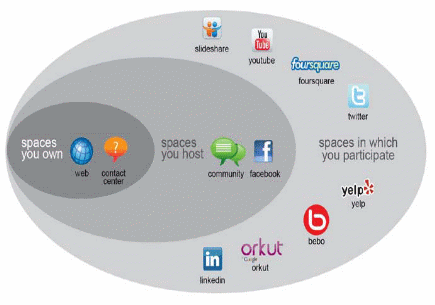
Source: (Oracle 2012)
The social web should be comprised of different spaces, which include spaces owned by the entrepreneur, spaces hosted, and the spaces in which the entrepreneur participates. The space owned by the entrepreneur may relate to the business official website, the contact center and the knowledge base while spaces hosted relate to YouTube and Facebook.
Businesses can exploit this trend in consumer behavior by designing a fan page on social media sites such as Facebook, which will play a critical role in increasing an organization’s customer base. Currently, it is estimated that approximately 165 million Twitter users, 500 million Facebook users, and 75 million LinkedIn users.
Additionally, approximately 200 billion videos are watched daily on YouTube (Thomas & Wasmund 2011). Using Facebook is relatively easy, which means that it is not a platform for only large businesses but also the small and medium-sized enterprises. Developing fan pages will enable businesses to leverage on social media viral capabilities.
Businesses should also design short videos containing the products and services issued and post them on social media platforms such as YouTube. Other social networking tools that can be used to post videos include Youku, which is a Chinese video streaming service.
Youku has assisted major companies such as IBM, Google, Pepsi, Nike, Mercedes-Benz and Nokia generate revenue. Consequently, using such tools will lead to the creation of a viral effect on the videos. Moreover, interacting with consumers through social media leads to the development of a strong customer relationship.
For example, an organization is able to access market feedback regarding its products and services. Safko (2012) is of the opinion that social media provides consumers with a 360-degree feedback mechanism. Thus, social media provides entrepreneurs with a perfect opportunity to respond to customer complaints and opinions hence enhancing the level of customer loyalty (Safko 2012).
Businesses and entrepreneurs should also interact with the online community through social media platforms such as LinkedIn, Yelp, Foursquare, Slideshare, and YouTube. Integrating social media also plays a critical role in increasing an organization’s sales revenue and hence the level of profitability.
Integrating with customers through various social media sites increases the likelihood of businesses and entrepreneurs, developing a clear understanding of the prevailing consumer needs (Bodnar & Cohen 2011). Consequently, an organization can be able to align its products to the prevailing customer needs.
The high rate of technological development with regard to ICT has led to the emergence of mobile devices such as Ipad and Ipods. In a bid to improve their effectiveness with regard to creating market awareness, it is essential for businesses to integrate mobile social media, which is achievable via developing a mobile social media application that is customised to a particular business.
This platform will increase the effectiveness with which an organization creates product and services awareness to potential consumers who do not have personal computers. The past few years have been characterized by an increment in the number of consumers who own tablets, iPads, and iPods. Consequently, it is imperative for entrepreneurs to take into account the developments in the social media.
Human resource management
Staffing; talent acquisition and management
The success of both large and small enterprises is dependent on the quality of human capital developed. Jacobson (2009) posits that a strong human capital base contributes towards achievement of the set organizational goals.
Firms can post job adverts on various social media platforms in an effort to improve the number of potential applicants. Fans on social media platforms can share job adverts with their friends and family members seeking a job (O’Leary et al. 2011).
Leanne (2012) is of the opinion that social media has been utilized by organizations in conducting a background evaluation of job candidates. Some of the sites that have previously been used concerning these aspects relate to LinkedIn, Twitter, and Facebook.
LinkedIn is ranked amongst the most effective social media platform with regard to recruitment of professionals (O’Leary et al. 2011). Its effectiveness hinges on the presumption that the platform is used to share professional information of its users. It is estimated that approximately 50% of Fortune 100 firms depend on LinkedIn in their recruitment drive. Therefore, using LinkedIn is considered very cost-effective (Pride, 2009).
By the end of 2012, Facebook had a following of over 900 million users. Consequently, employers can obtain substantial background information regarding job applicants without having to leave their office. A survey conducted by Microsoft revealed that approximately 79% of managers in the US had utilized social media in their employee recruitment processes.
Seventy percent (70%) of the managers revealed that they had rejected job applications because of the posts and comments on online platforms by the applicants. This aspect highlights the importance of developing good online reputation by posting positive comments. Social media provide organizations with an opportunity to expand their talent pool by improving its connectivity with passive jobseekers (Leanne 2012).
Another avenue through which businesses can use social media entails ensuring that the employees comply with the set rules and regulations. Consequently, it is imperative for HR managers to ensure that an effective internal communication system is implemented. A study conducted by KPMG shows that organizations could use social media to develop the employees’ talent.
For example, an organization can leverage on social media by ensuring that they are connected with special interest groups such as mentoring group and volunteerism. Organizations can also utilize social media by developing expert directories comprised of employees who are conversant with one another.
Mobility and collaboration
Emergence of new technology and change in employees needs presents a major challenge for HR managers in their pursuit to develop a strong human resource base (Somers et al. 2009). For example, the emergence of mobile social media devices has led to the creation of a prospect for immediacy amongst the modern workforce.
Organizations can use social media to improve the degree of collaboration amongst employees. Currently, organizations are increasingly using projects in their quest to improve their performance. However, successful implementation of projects is dependent on the degree of coordination amongst the project team members.
Using various social media platforms improves communication and interaction within project teams as illustrated by Thomas and Barlow (2011) who posit that a team “remains the most flexible and the most powerful unit of performance, learning, and change in any organization” (p. 30). Through social media, project team members can be able to share valuable knowledge and information.
Incorporating social media is also paramount in developing a strong multigenerational workforce. Safko (2012) is of the opinion that communication “serves as a strategic change level by facilitating the transition of awareness to the actual ownership and adoption and integration of social media tools and guidelines” (p. 6).
Research and development
The number of social media users has grown exponentially. This trend is expected to continue into the future. Consequently, social media provides organizations with an opportunity to undertake research and development. Soderman and Dolles (2013) are of the opinion that this goal is achievable via undertaking marketing research through the social media platforms.
For example, an organization can utilize the customers’ responses on social media regarding its products and services in their new product and continuous product development processes. Moreover, a number of social media monitoring tools have been developed due to increased innovations with regard to social media.
Radian6 and Spredfast.com are some of the companies that have developed platforms that can be used in the process of conducting marketing research. The platform is comprised of well-developed web-based software that can be used in managing social media marketing.
Using such tools can enable an organization to evaluate the profitability potential of its target market by analyzing the size of the target audience and their level of market engagement. Gaining such knowledge can give entrepreneurs insight on how to improve its branding strategies.
Other web-based software that can assist businesses in determining the number of visitors who view the firm’s social media platforms such as Facebook, LinkedIn, Twitter, Flickr, and YouTube updates have been developed (Soderman & Dolles 2013).
Research methodology
The success of a particular study is influenced by the quality of the research framework adopted. Creswell and Clark (2011) posit that it is fundamental for researchers to incorporate an effective research design outlining the method collecting and analyzing the data collected (Maxwell 2005).
Both qualitative and quantitative research designs were used in this study. Qualitative research design enabled the researcher to acquire a substantial amount of data from the target population by conducting an in-depth analysis of the subject under investigation.
On the other hand, quantitative research design was incorporated in order to improve the process of interpreting the research findings, which will be achieved by integrating numerical aspects of the phenomenon.
Population and sample
Organizational leaders and individual entrepreneurs from well-established businesses were targeted as the study population. This choice of the target population was informed by the knowledge that such individuals have sufficient knowledge regarding on the importance of ICT in the operation of an organization.
Random sampling technique was incorporated in selecting the sample. Thus, the researcher was able to eliminate bias in selecting the sample; all the individuals in the target population had the same likelihood of being selected as the target population (Deming 2002). A sample size of 100 respondents was selected from the target population.
Data collection
Primary and secondary methods of data collection were adopted. Secondary data were obtained by reviewing published reports and surveys on the subject.
However, it was ensured that only credible sources of data were utilized. Thus, only relevant data was collected. On the other hand, primary methods entailed using data collection instruments such as questionnaires and interviews.
Analysis and presentation
The objective of this research is to develop a comprehensive understanding of the role of social media in enhancing the level of profitability in businesses. Moreover, the study intends to investigate the social media strategies that organizations can integrate in order to improve organizational performance and productivity. The researcher asked questions with regard to these aspects and obtained varied responses, as illustrated herein.
Analysis of research questions
The researcher asked the respondents a number of questions to gauge whether the respondents have had any experience using social media in their marketing processes. Seventy percent of the respondents were of the opinion that they had used social media for personal purposes at one point.
On the other hand, 30% of the respondents said that they had not incorporated social media in life, which explains the low rate of integration of social media in business operation especially amongst small businesses. When asked whether social media is important in their business operation, the respondents gave varied opinions as illustrated in the chart below.
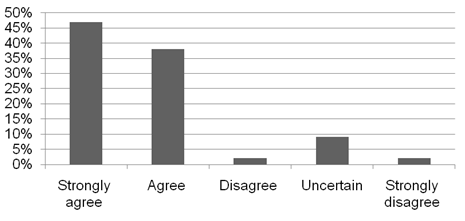
Despite concurring that social media marketing through emerging social media networks is valuable for business operation, only 37% of the respondents said that they have used Facebook in their business-to-consumer marketing processes at one point.
On the other hand, 29% of the respondents said that their organisations had integrated social media in their business-to-business marketing activities, which represents a relatively low rate of integration of social media in marketing activities.
Considering the significance of effective market communication in business operation, it is imperative for entrepreneurs to align their business operation to market changes. The researcher was interested in knowing whether the businesses have integrated any social media in their traditional market communication activities. The results obtained varied as illustrated in the chart below.
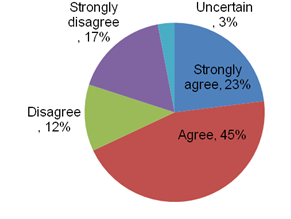
In addition to computer-based social media platforms, the researcher intended to know whether the respondent’s businesses had developed mobile-optimised social media platforms. Ninety-seven (97%) of the respondents said that their businesses had not done so, which underscores the low rate of social media appreciation amongst business activities.
In a bid to understand the businesses’ commitment to social media marketing, the researcher sought to understand the number of hours that the businesses commit to undertake social media marketing per week. The results obtained are illustrated below.
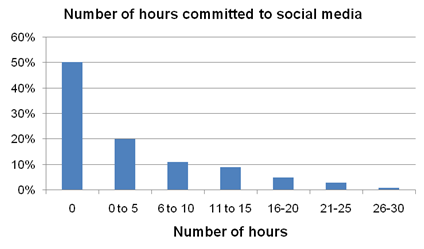
When asked about the benefits of social media in an organisation’s marketing practices, the respondents cited a number of benefits as illustrated below.
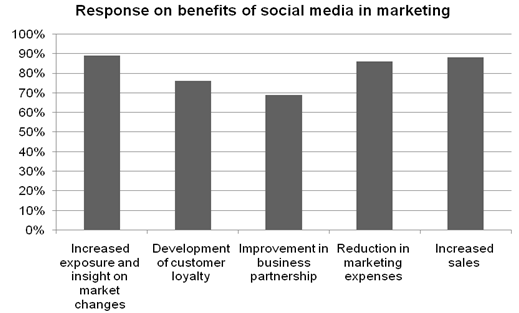
Eighty percent (80%) of the respondents said that an organisation could utilise the market feedback obtained in their continuous product innovation by undertaking an online market research. The respondents were of the opinion that organisations can use social media to gain insight on consumer complaints regarding the firm’s products and services.
Moreover, the research can be focused on both the competitors and the customers. Despite their concurrence with the role of social media in research and development in an organisation’s operations, 90% of the respondents said that their businesses have not adopted social media in gaining market intelligence.
The study also intended to evaluate the extent to which entrepreneurs have incorporated social media in their human resource management practices. The responses obtained in this regard show that businesses have not appreciated the role of social media in developing a strong human resource base. The chart below illustrates the responses obtained.
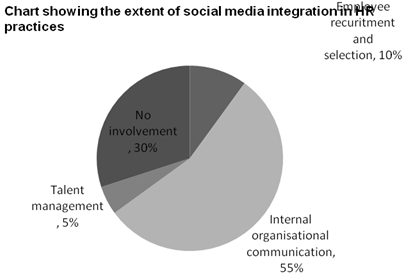
Discussion
From the literature review, it is evident that innovations with regard to information communication technology are likely to continue into the future. Social media is one of the greatest revolutions of the 21st century.
The high rate of innovation with regard to social media means that its importance in our daily lives is likely to increase. Consequently, it is imperative for businesses to evaluate how best they can utilise the new technology.
Some of the areas that entrepreneurs can consider integrating include marketing, human resource management and market research. The study shows that social media can improve the effectiveness with which an organisation undertakes its marketing activities. One of these activities relates to creating marketing communication.
Businesses can use different social media platforms for advertising their products and services. The likelihood of a business creating market awareness regarding its operations to a wide range of potential customers is high considering the high rate at which customers have integrated social media in their lifestyle.
Moreover, social media marketing can enable an organisation to develop a strong relationship with other parties in the supply chain. Another major benefit of social media marketing is that it is cost-effective. Czinkota (2009) is of the opinion that a huge gap exists between social and traditional media.
Czinkota (2009) posits that it is imperative for both large and small businesses to evaluate how they can incorporate social media in their human resource management practices. The study confirms that social media networks are redefining how businesses undertake their HR management practices.
Previously, entrepreneurs relied on traditional methods of recruit employees, which no longer the case as businesses are relying on the connectivity of job applicants through various social media platforms in order to understand their background. Consequently, an organisation is in a position to develop a strong workforce.
Social media can also be used to nurture a strong organisational culture. For example, a business can use social media to interact with internal stakeholders such as employees, which will lead to the creation of a sense of involvement amongst employees. Consequently, the probability of developing a strong degree of organisational identification amongst employees is developed.
In their quest to gain new market intelligence. Consequently, social media can be defined as a double-edged showed in that entrepreneurs can understand both positive and negative market feedback regarding its operation (Czinkota 2009). Previously, businesses had a limited scope within which they would have undertaken market research.
Today, businesses can undertake market research on potential customers who are widely dispersed. Consequently, businesses are able to adjust their products and services to the prevailing market needs.
Moreover, such a market research can enable a firm to develop products that can be accepted in the international market. Thus, the likelihood of achieving profit maximisation goal is high.
The study also shows that an organisation can use social media to improve its public image by interacting with customers. For example, an organisation can gain insight on how its products and services contribute to customer satisfaction.
Moreover, an organisation can use social media to clarify its position and strategy to deal with the crisis that occurs in the course of its operation. Integrating social media in managing crisis will enhance the process by making it participatory.
Thus, the likelihood of attaining effectiveness and efficiency in managing product and store loyalty amongst the customers will be improved. The study shows that there is minimal integration of social media in business operations, especially amongst SMEs.
Conclusion and recommendations
Social media has undergone significant transformations over the past few decades as evidenced by the large number of social media platforms. Their emergence has had a significant impact on society’s behaviour and experience.
Consequently, it is imperative for businesses to consider the most appropriate ways through which they can integrate social media in their operational strategies. However, the study shows that businesses, especially SMEs have not fully appreciated the contribution of social media in their operation.
Integrating social media in business operation can enhance an organisation’s competitiveness in a number of areas, which include marketing, human resource management and product research and development. Integrating social media in organisations’ marketing practices can lead to improvement in the firms’ level of profitability by creating sufficient market awareness regarding the product and service offered. Therefore, the likelihood of increasing the sales revenue is high and hence profitability is high.
The study also underscores the importance of social media in developing a strong human resource base by using social media in their employee recruitment drives. Using social media in the recruitment drive enables an organisation to tap talent from a relatively wide labour market.
Thus, an organisation can be able to develop a strong human capital base. The study also shows that organisations can also use social in gaining market intelligence on various aspects.
Therefore, businesses and entrepreneurs should consider integrating social media in their marketing, human resource management and operational processes.
However, it is important for businesses to ensure that they have integrated effective corporate governance and ethical mechanisms in order to improve the effectiveness of utilising social media. A holistic internal strategy on how to utilise social in the businesses operation should be formulated.
Moreover, a strong team comprised of individuals who are conversant on how to utilise social media in marketing, human resource management and research and development should be formulated, which will increase the likelihood of successfully incorporating the social media strategy.
Reference List
Bodnar, K & Cohen, J 2011, The B2B social media book: become a marketing superstar by generating leads with blogging, LinkedIn, Twitter, Facebook, Email and more, John Wiley and Sons, Hoboken.
Brunty, J, Helenek, K & Miller, L 2013, Social media investigation for law enforcement, Elsevier Science, Oxford.
Creswell, J & Clark, P 2011, Designing and conducting mixed methods research, Sage Publications, Thousand Oaks.
Czinkota, M 2009, International marketing, Cengage Learning, London.
Deming, W 2002, Sample design in business research, John Wiley and Sons, New York.
Jacobson, J 2009, 42 rules of social media for small business, Superstar Press, Cupertino.
Jadhav, M, Kamble, R & Patil, M 2009, ‘Social media marketing: the next generation of business trends’, Journal of Computer Engineering, vol. 3, pp. 45-59.
Leanne, M 2012, ‘Social media and employment: Is there a limit?’ Interdisciplinary Journal of Contemporary Research in Business, vol. 4 no.1, pp. 1-8.
O’Leary, S, Sheehan, K & Lentz, S 2011, Small business smarts; building buzz with social media, Praeger, Santa Barbara.
Oracle: Is social media transforming your business. 2012. Web.
Maxwell, J 2005, Qualitative research design: an interactive approach, Sage Publication, New Jersey.
Pride, W 2009, Business, Cengage Learning, New York.
Remenyi, D 2008, The 5th international conference on intellectual capital, Academic Public International, New York.
Safko, L 2012, The social media bible; tactics, tools and strategies for business success, John Wiley and Sons, Hoboken.
Soderman, S &Dolles, H 2013, Handbook of research on sports and business, Edward Elgar, Cheltenhan.
Somers, G, Cain, J & Jeffrey, M 2009, Essentials VCE business management. Units 1 and 2, Cambridge University Press, Cambridge.
Sweeney, S & Craig, R 2011, Social media for business; 101 ways to grow your business without wasting your time, Maximum Press, Gulf Breeze, FL.
Thomas, D & Barlow, M 2011, The executive’s guide to enterprise social media strategy; how social networks are radically transforming your business, Wiley, Hoboken.
Thomas, M &Wasmund, S 2011, The smarter way to do business, Capstone, Chichester.
Waters, M 2013, Guide to starting a business, AuthorHouse, London.